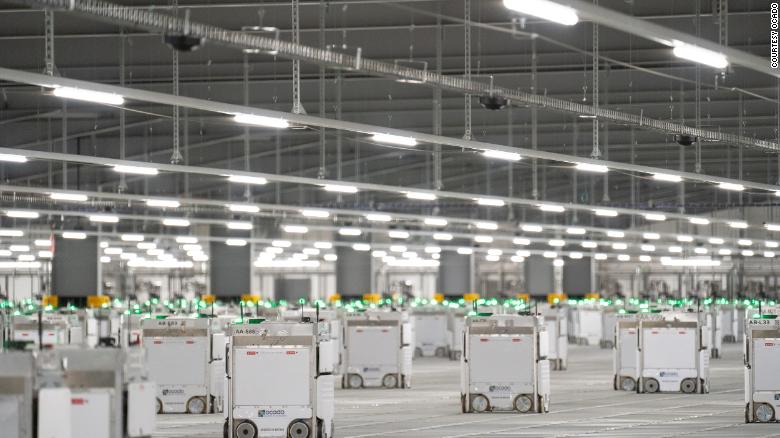
©CNN
Pre-reading questions:
I will read each question. Then, please answer them.
講師がそれぞれの質問を読むので答えましょう。
- Do you like robots?
- What is the most advanced robot you have you seen?
Vocabulary:
I will read the words, meanings, and sample sentences. Then, repeat after me.
単語、意味、例文を読みます。講師に続いて音読しましょう。
- originally /uh-RIJ-uh-nl-ee/
- develop /dih-VEL-uhp/
- available /uh-VEY-luh-buhl /
- route /root/
- transfer /trans-FUR/
[adverb] – in the beginning; when something first existed
The album was originally released in 1974.
[verb] – to (cause something to) grow or change into a more advanced, larger, or stronger form
You need to develop a positive mental attitude.
[adjective] – able to be bought or used
They are often available at a discount.
[noun] – a particular way or direction between places
Motorists are advised to find an alternative route.
[verb] – to move someone or something from one place, vehicle, person, or group to another
How can I transfer money from my bank account to his?
Article reading:
Please read the whole article. Then, I will check your pronunciation and intonation.
記事を音読しましょう。講師はあなたの発音とイントネーションを確認します。
In a warehouse the size of three football fields, 3,000 robots move at 13 feet per second, sliding to avoid each other in a pleasant dance programmed by artificial intelligence. What do they hope to accomplish? The goal is to get your groceries in as little time as possible. The British online retailer Ocado runs the warehouse in southeast London, which is equipped with the most advanced automated equipment. The Ocado Smart Platform (OSP) was originally developed for the company’s usage, but it is now available to other supermarkets.
The bots, which look like washing machines on wheels, move like chess pieces over a grid. A stack of up to 21 containers is hidden beneath each tile. The containers hold some of Ocado’s 50,000 products, which are stored based on data that tells when they will be needed. When the warehouse receives an order, the bots wake up and run to the container they need, passing each other within five millimeters. Alex Harvey, Ocado Technology’s chief of advanced technologies, adds, “We basically play chicken with them: they go on a collision course only to divert at the last moment.” The bots aren’t independent; rather, they’re guided by a system that plans their routes for them, similar to air traffic control. Each bot includes a grasping mechanism that allows it to handle one container. For example, if a product is stored five containers down, four bots will remove the containers above it first, freeing up space for a “hero” bot who is completing an order.
When the “hero” bot has a container in its hands, it transports it to a picking station, where a person selects it and adds it to an order (or another robot, depending on the technology used in each warehouse). The completed order is then transferred to a van for final delivery. “Labor costs are one of the key driving factors in the cost of groceries,” says Harvey, “and our goal is to try to automate these very repetitive, not particularly exciting human operations in the warehouse.
The bots, which look like washing machines on wheels, move like chess pieces over a grid. A stack of up to 21 containers is hidden beneath each tile. The containers hold some of Ocado’s 50,000 products, which are stored based on data that tells when they will be needed. When the warehouse receives an order, the bots wake up and run to the container they need, passing each other within five millimeters. Alex Harvey, Ocado Technology’s chief of advanced technologies, adds, “We basically play chicken with them: they go on a collision course only to divert at the last moment.” The bots aren’t independent; rather, they’re guided by a system that plans their routes for them, similar to air traffic control. Each bot includes a grasping mechanism that allows it to handle one container. For example, if a product is stored five containers down, four bots will remove the containers above it first, freeing up space for a “hero” bot who is completing an order.
When the “hero” bot has a container in its hands, it transports it to a picking station, where a person selects it and adds it to an order (or another robot, depending on the technology used in each warehouse). The completed order is then transferred to a van for final delivery. “Labor costs are one of the key driving factors in the cost of groceries,” says Harvey, “and our goal is to try to automate these very repetitive, not particularly exciting human operations in the warehouse.
True or False:
Read the sentences and identify if they are true or false based on the article.
文章を読んで、記事に基づいて正誤を答えましょう。
- The warehouse is the size of three football fields.
- The goal is to get your groceries in as little time as possible.
- Alex Harvey is Ocado Technology’s chief of advanced technologies.
- The bots are self-autonomous.
- Labor costs are one of the key driving factors in the cost of groceries.
Fill in the blanks:
Choose the correct word from the table then fill in the blanks.
適切な言葉を選んで空欄を埋めましょう。
| originally | develop | available | route | transfer |
- Can I __________ to a new office?
- The family __________ came from France.
- Tickets are __________ from the box office.
- Researchers are collaborating to __________ the vaccine.
- What’s the best __________ to Cambridge?